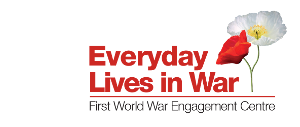Contributed by Julie Moore
Over the past three years, the ‘Everyday Lives in War’ team have heard many stories of how people coped during the four years of the First World War. From allotments to food queues, shell baskets to straw hats, fortune telling to popular entertainment, individuals and researchers across a range of locations and organisations are uncovering some of the less familiar and unique stories from their own communities. These, in turn, are connecting with stories from other parts of the world, creating communities of interest where the local experience brings more colour and texture to the picture we are building of everyday life.
In the course of my own research into food and farming, I have noticed that very often a line will appear in early 20th century minute books or newspaper accounts referencing ‘the ladies’; anonymous women who are organising a range of social events, charitable collections, food distribution and a host of other unpaid but necessary roles within the community.

Ladies of Caton Canteen, Lancaster, ca 1917 © IWM (Q108313)
www.iwm.org.uk/collections/item/object/205351135
This interest in ‘anonymous women’ has no real direction at present, but I am curious to see where it leads. Over the next months, as this research continues, I will be posting the occasional blog on the range of roles these women were performing and, where possible, seeking to identify them. I am also keen to share the research process. So often we see the finished, polished article from historians which can make it seem as if these things come into our heads fully fledged and are just waiting for the historian to bring them into the public domain. Research is much messier than that, as I am sure many of those reading this have discovered, so this is going to be a ‘warts and all’ account of the wrong turnings, backtrackings, and blank mind which so often accompany those moments of breakthrough and fist pumping excitement.
I would also like to connect all those of us who have been working on community stories. It would be good if we could start to bring together a sense of the type of tasks these anonymous women were taking on. If you are currently working on your own local story or indeed have finished your project, I invite you to look and see how often these unnamed women appear, keeping the wheels of their local communities rolling along. Where are they most likely to be found? Is it in the traditional roles as stalwarts of the local church or chapel, pouring innumerable cups of tea, or are they taking on more activist roles around issues on food? Are they, in fact, the same women, and does pouring tea feature as a constant? We should not underplay the part that tea (and cake) play in bringing people together and getting things done. When looking for an image to accompany this piece, that idea of the tea urn was very much at the front of my mind.
I am not sure where this will take us, but the unexpected is often the greatest joy of research. If nothing else, we will give these unnamed women their moment in the spotlight. However, hopefully we can bring them together to show how, away from the headlines, women of all ages and economic background were supporting each other and their local community – or perhaps not. For we must not be afraid, either, of uncovering tales of selfish, mean-spirited women as these too have their place in the story of those whose lives coincided with a time of war.
I should add here that, as historians, we can never be neutral in our research. Along with many other women, I have taken my turn on the tombola stall, dishing out tea and cake, or washing up in school, church and community centre halls. I doubt my name is recorded anywhere, nor the names of those who stood alongside me. Yet I like to think those hours were of some value, and this may well by why my mind turned to these women when encountering that phrase time and time again: ‘the ladies’. They seemed ‘like me’ but, of course, they were as like or unlike me as any group of people can be, and it is something of which we all need to be aware when considering any class, gender or social group. We carry our pasts and assumptions with us wherever we go, and that can sometimes be a great asset as it helps us to identify resonances in the lives of those who went before us. Yet it can also be a limitation when we assume too much, and so I will try my best to be led by the sources whilst acknowledging how my own experiences influence my understanding. Romanticising the past does a disservice to those whose lived experience was coping with the anxieties, hardships, and, yes, sometimes opportunities, of everyday life during the First World War.
As well as my own research, it would be great to hear from you on what you have uncovered about these anonymous women, and we would be happy to post contributions on this subject on our website. We are keen to capture the research process, so if you have been tearing your hair out trying to find out more about your own ‘ladies’, then let us know. Equally, if you are triumphant at having found a source which brings them into the spotlight, then sharing that source might help others on the same journey. For those of you who use twitter the #FWWWomen is one way of linking our thoughts and stories together.
This may come to nothing, but let’s see where the anonymous women lead us.
You can contact us with your thoughts and stories at firstworldwar@herts.ac.uk




